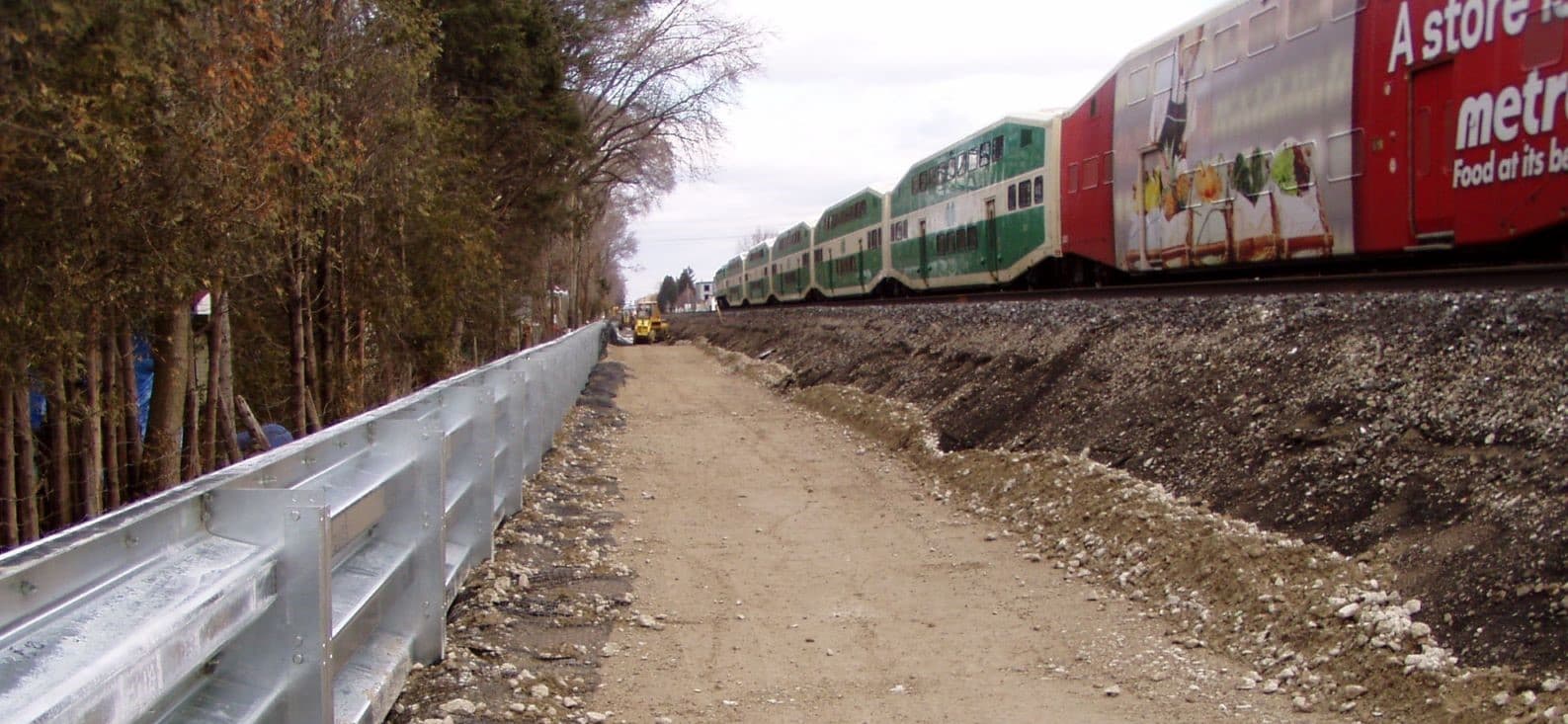
Products
Industries
MSE walls with MIRAGRID XT for rail expansion
Overview
In response to growing commuter demands between Hamilton and Toronto, Ontario, GO Transit undertook a significant infrastructure expansion, necessitating the addition of a third track along the Lakeshore West Line. This project, located in the Lorne Park area of Mississauga, faced considerable challenges due to space constraints and the need to maintain uninterrupted service on the existing rail lines.
To accommodate the new track, seven retaining walls were required to stabilize the embankment while optimizing the use of the available land. The project team, led by Hatch Mott MacDonald, initially considered traditional gravity retaining walls but ultimately selected a combination of Bin-Wall and Mechanically Stabilized Earth (MSE) retaining walls reinforced with MIRAGRID® XT geogrids.
The project’s design team initially explored several wall systems, but due to the complex site constraints, including limited access and proximity to the existing rail lines, the team opted for a hybrid solution. The chosen system combined a galvanized steel crib wall fascia with MIRAGRID XT geogrids, forming a unique MSE wall solution that was both cost-effective and straightforward to construct.
MIRAGRID XT Geogrids were selected for their high tensile strength and durability, making them ideal for railway applications. Specifically, MIRAGRID 3XT was used, providing a Long-Term Design Strength (LTDS) of 28 kN/m (1920 lb/ft), which met the stringent demands of the rail embankment project. The geogrids were oriented perpendicular to the wall face, ensuring optimal load distribution and reinforcement.
The geogrids were integrated with the galvanized steel crib wall fascia using a simple yet effective wrapping technique. This connection method ensured that the geogrids remained securely in place throughout the construction process, even under the high live loads imposed by the passing trains. The use of standard galvanized steel crib wall components for the fascia-to-geogrid connection further streamlined the construction process, reducing potential for errors and increasing overall efficiency.
The selection of MIRAGRID XT geogrids for this project reflects a strong commitment to both sustainability and resilience in railway infrastructure. By enabling the construction of stable embankments with reduced material usage, the geogrids contributed to a lower environmental impact, aligning with sustainable construction practices. Their durability and long-term performance further minimized the need for maintenance, reducing the overall lifecycle environmental footprint.
In terms of resilience, the hybrid wall system proved adaptable to the challenging site conditions and harsh winter climate, maintaining structural integrity under heavy rail loads and environmental stressors. The geogrids’ ability to reinforce the embankment effectively ensured that the railway infrastructure could withstand both daily operational stresses and unexpected conditions, making this project a model for future rail expansions.
Construction Challenges
Construction of the retaining walls occurred during the winter of 2009, which introduced additional complexities. Low temperatures and frequent precipitation required the project team to adapt their methods, particularly concerning the placement and compaction of the backfill material, which conformed to Ontario Provincial Standard Specification (OPSS) 1010 Granular B Type 1.
Site constraints, particularly the limited access for construction vehicles and the necessity to halt work during train passages, posed significant challenges. Despite these hurdles, the combination of MIRAGRID XT geogrids and galvanized steel crib wall fascia proved resilient, with the walls being constructed efficiently and effectively, even under these demanding conditions.
Conclusion
The successful implementation of the MSE retaining walls using MIRAGRID XT geogrids not only met the project’s engineering and economic objectives but also demonstrated the versatility and reliability of geogrid reinforcement in railway applications. The hybrid wall system provided a robust solution that accommodated the project’s unique constraints while ensuring long-term performance.
For design engineers in the rail industry, this case study highlights the importance of selecting the right materials and methods for challenging construction environments. MIRAGRID XT geogrids, with their proven strength and ease of installation, offer a compelling solution for similar infrastructure projects where space is limited, and reliability is paramount.



Explore more case studies
View allMIRAFI geotextiles prevent subgrade failure and reduce track downtime
Canadian Pacific Railway (CP) identified track settlement issues and partnered with Solmax and Clifton Associates to implement a geosynthetic solution, reducing ballast use by 43% and completing repairs on a 72 ft section in under seven hours.
Stabilizing soft clay soils and shallow utilities during the reconstruction of Main Street
Main Street in Palisade, CO, was reconstructed using geosynthetics to address soft soils and shallow utilities, reducing excavation and aggregate use.
MIRAFI geotextiles optimize stability and reduce costs at Cargill’s Regina facility
Cargill's Regina facility used MIRAFI H2Ri to stabilize expansive, frost-susceptible soils, reducing sub-ballast thickness by 55% and road construction costs by 20%.